2011 Peugeot 308 SW BL dashboard
[x] Cancel search: dashboardPage 37 of 356
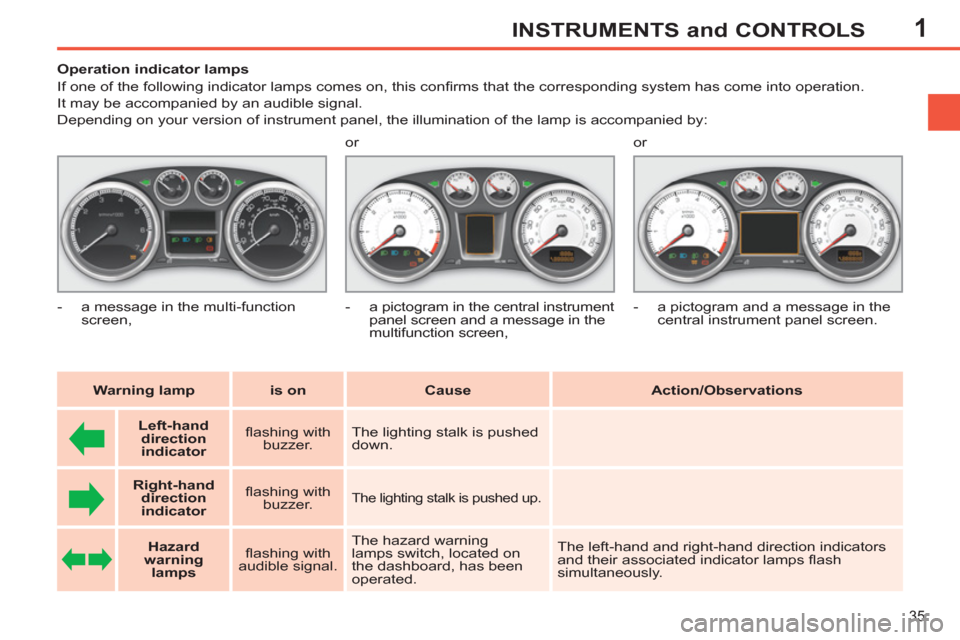
1
35
INSTRUMENTS and CONTROLS
Operation indicator lamps
If one of the following indicator lamps comes on, this confi rms that the corresponding system has come into operation.
It may be accompanied by an audible signal.
Depending on your version of instrument panel, the illumination of the lamp is accompanied by:
Warning lamp
is on
Cause
Action/Observations
Left-hand
direction
indicato
r
fl ashing with
buzzer. The lighting stalk is pushed
down.
Right-hand
direction
indicator
fl ashing with
buzzer.
The lighting stalk is pushed up.
Hazard
warning
lamps
fl ashing with
audible signal. The hazard warning
lamps switch, located on
the dashboard, has been
operated. The left-hand and right-hand direction indicators
and their associated indicator lamps fl ash
simultaneously.
- a message in the multi-function
screen, or
- a pictogram in the central instrument
panel screen and a message in the
multifunction screen, or
- a pictogram and a message in the
central instrument panel screen.
Page 39 of 356
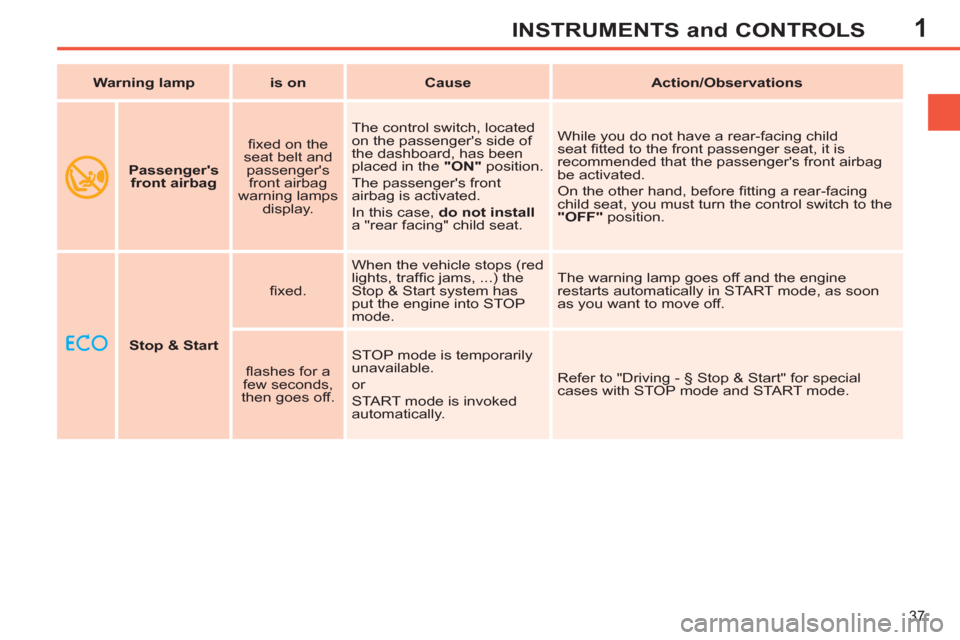
1
37
INSTRUMENTS and CONTROLS
Stop & Start
fi xed. When the vehicle stops (red
lights, traffi c jams, ...) the
Stop & Start system has
put the engine into STOP
mode. The warning lamp goes off and the engine
restarts automatically in START mode, as soon
as you want to move off.
fl ashes for a
few seconds,
then goes off. STOP mode is temporarily
unavailable.
or
START mode is invoked
automatically. Refer to "Driving - § Stop & Start" for special
cases with STOP mode and START mode.
Warning lamp
is on
Cause
Action/Observations
Passenger's
front airbag
fi xed on the
seat belt and
passenger's
front airbag
warning lamps
display. The control switch, located
on the passenger's side of
the dashboard, has been
placed in the "ON"
position.
The passenger's front
airbag is activated.
In this case, do not install
a "rear facing" child seat. While you do not have a rear-facing child
seat fi tted to the front passenger seat, it is
recommended that the passenger's front airbag
be activated.
On the other hand, before fi tting a rear-facing
child seat, you must turn the control switch to the
"OFF"
position.
Page 40 of 356
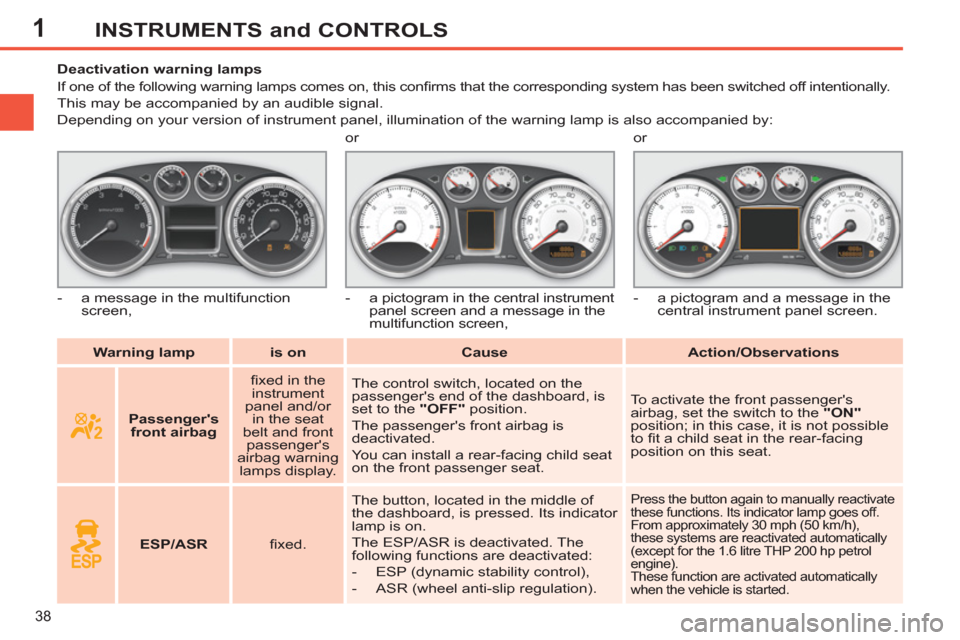
1
38
INSTRUMENTS and CONTROLS
Warning lamp
is on
Cause
Action/Observations
Deactivation warning lamps
If one of the following warning lamps comes on, this confi rms that the corresponding system has been switched off intentionally.
This may be accompanied by an audible signal.
Depending on your version of instrument panel, illumination of the warning lamp is also accompanied by:
Passenger's
front airbag
fi xed in the
instrument
panel and/or
in the seat
belt and front
passenger's
airbag warning
lamps display. The control switch, located on the
passenger's end of the dashboard, is
set to the "OFF"
position.
The passenger's front airbag is
deactivated.
You can install a rear-facing child seat
on the front passenger seat. To activate the front passenger's
airbag, set the switch to the "ON"
position; in this case, it is not possible
to fi t a child seat in the rear-facing
position on this seat.
ESP/ASR
fi xed. The button, located in the middle of
the dashboard, is pressed. Its indicator
lamp is on.
The ESP/ASR is deactivated. The
following functions are deactivated:
- ESP (dynamic stability control),
- ASR (wheel anti-slip regulation).
Press the button again to manually reactivate
these functions. Its indicator lamp goes off.
From approximately 30 mph (50 km/h),
these systems are reactivated automatically
(except for the 1.6 litre THP 200 hp petrol
engine).
These function are activated automatically
when the vehicle is started.
- a message in the multifunction
screen, or
- a pictogram in the central instrument
panel screen and a message in the
multifunction screen, or
- a pictogram and a message in the
central instrument panel screen.
Page 64 of 356
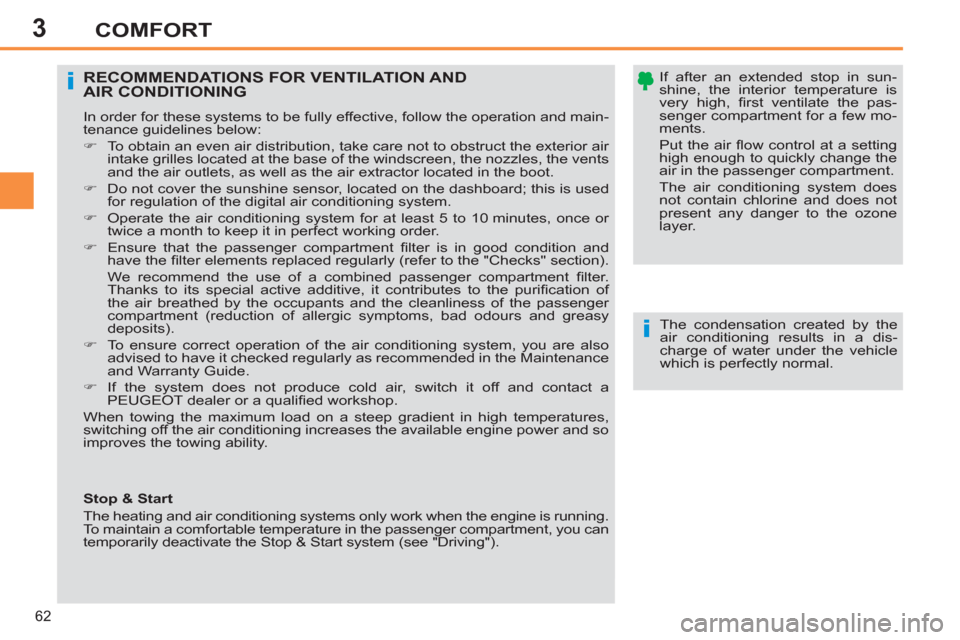
3
i
i
62
COMFORT
If after an extended stop in sun-
shine, the interior temperature is
very high, fi rst ventilate the pas-
senger compartment for a few mo-
ments.
Put the air fl ow control at a setting
high enough to quickly change the
air in the passenger compartment.
The air conditioning system does
not contain chlorine and does not
present any danger to the ozone
layer.
RECOMMENDATIONS FOR VENTILATION AND
AIR CONDITIONING
In order for these systems to be fully effective, follow the operation and main-
tenance guidelines below:
�)
To obtain an even air distribution, take care not to obstruct the exterior air
intake grilles located at the base of the windscreen, the nozzles, the vents
and the air outlets, as well as the air extractor located in the boot.
�)
Do not cover the sunshine sensor, located on the dashboard; this is used
for regulation of the digital air conditioning system.
�)
Operate the air conditioning system for at least 5 to 10 minutes, once or
twice a month to keep it in perfect working order.
�)
Ensure that the passenger compartment fi lter is in good condition and
have the fi lter elements replaced regularly (refer to the "Checks" section).
We recommend the use of a combined passenger compartment fi lter.
Thanks to its special active additive, it contributes to the purifi cation of
the air breathed by the occupants and the cleanliness of the passenger
compartment (reduction of allergic symptoms, bad odours and greasy
deposits).
�)
To ensure correct operation of the air conditioning system, you are also
advised to have it checked regularly as recommended in the Maintenance
and Warranty Guide.
�)
If the system does not produce cold air, switch it off and contact a
PEUGEOT dealer or a qualifi ed workshop.
When towing the maximum load on a steep gradient in high temperatures,
switching off the air conditioning increases the available engine power and so
improves the towing ability.
The condensation created by the
air conditioning results in a dis-
charge of water under the vehicle
which is perfectly normal.
Stop & Start
The heating and air conditioning systems only work when the engine is running.
To maintain a comfortable temperature in the passenger compartment, you can
temporarily deactivate the Stop & Start system (see "Driving").
Page 87 of 356
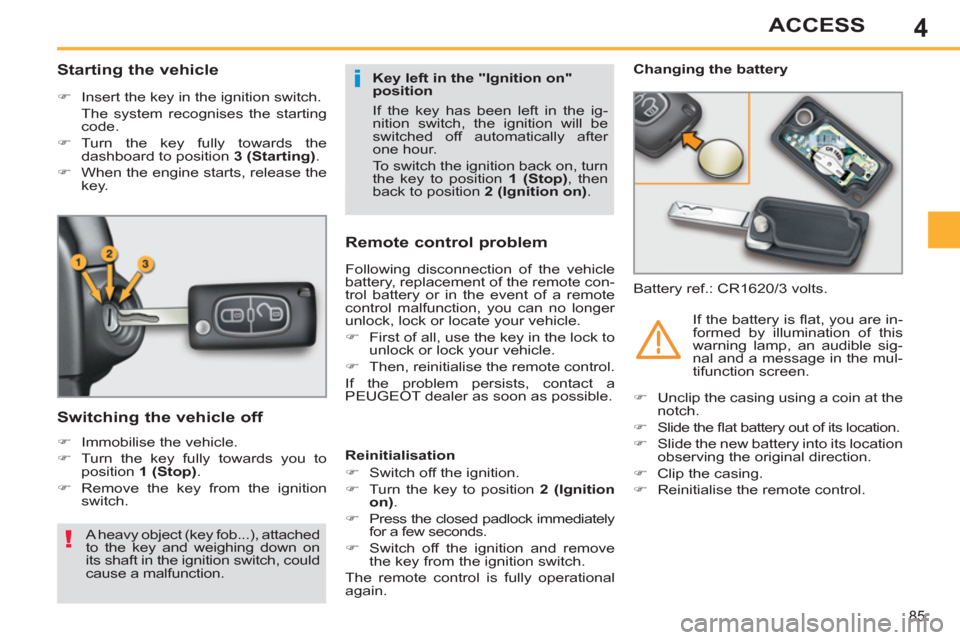
4
i
!
85
ACCESS
Starting the vehicle
�)
Insert the key in the ignition switch.
The system recognises the starting
code.
�)
Turn the key fully towards the
dashboard to position 3 (Starting)
.
�)
When the engine starts, release the
key.
Switching the vehicle off
�)
Immobilise the vehicle.
�)
Turn the key fully towards you to
position 1 (Stop)
.
�)
Remove the key from the ignition
switch.
Remote control problem
Following disconnection of the vehicle
battery, replacement of the remote con-
trol battery or in the event of a remote
control malfunction, you can no longer
unlock, lock or locate your vehicle.
�)
First of all, use the key in the lock to
unlock or lock your vehicle.
�)
Then, reinitialise the remote control.
If the problem persists, contact a
PEUGEOT dealer as soon as possible.
Changing the battery
Battery ref.: CR1620/3 volts.
Reinitialisation
�)
Switch off the ignition.
�)
Turn the key to position 2 (Ignition
on)
.
�)
Press the closed padlock immediately
for a few seconds.
�)
Switch off the ignition and remove
the key from the ignition switch.
The remote control is fully operational
again. If the battery is fl at, you are in-
formed by illumination of this
warning lamp, an audible sig-
nal and a message in the mul-
tifunction screen.
Key left in the "Ignition on"
position
If the key has been left in the ig-
nition switch, the ignition will be
switched off automatically after
one hour.
To switch the ignition back on, turn
the key to position 1 (Stop)
, then
back to position 2 (Ignition
on
)
.
�)
Unclip the casing using a coin at the
notch.
�)
Slide the fl at battery out of its location.
�)
Slide the new battery into its location
observing the original direction.
�)
Clip the casing.
�)
Reinitialise the remote control.
A heavy object (key fob...), attached
to the key and weighing down on
its shaft in the ignition switch, could
cause a malfunction.
Page 112 of 356
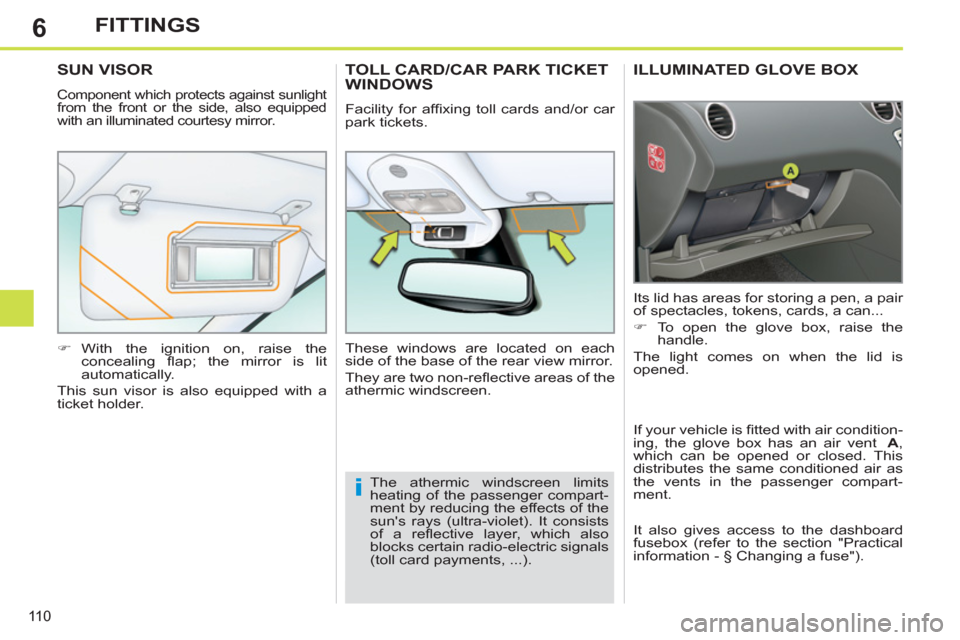
6
i
11 0
FITTINGS
ILLUMINATED GLOVE BOX
Its lid has areas for storing a pen, a pair
of spectacles, tokens, cards, a can...
�)
To open the glove box, raise the
handle.
The light comes on when the lid is
opened.
SUN VISOR
Component which protects against sunlight from the front or the side, also equipped
with an illuminated courtesy mirror.
�)
With the ignition on, raise the
concealing fl ap; the mirror is lit
automatically.
This sun visor is also equipped with a
ticket holder.
TOLL CARD/CAR PARK TICKET
WINDOWS
Facility for affi xing toll cards and/or car
park tickets.
These windows are located on each
side of the base of the rear view mirror.
They are two non-refl ective areas of the
athermic windscreen.
The athermic windscreen limits
heating of the passenger compart-
ment by reducing the effects of the
sun's rays (ultra-violet). It consists
of a refl ective layer, which also
blocks certain radio-electric signals
(toll card payments, ...). If your vehicle is fi tted with air condition-
ing, the glove box has an air vent A
,
which can be opened or closed. This
distributes the same conditioned air as
the vents in the passenger compart-
ment.
It also gives access to the dashboard
fusebox (refer to the section "Practical
information - § Changing a fuse").
Page 140 of 356
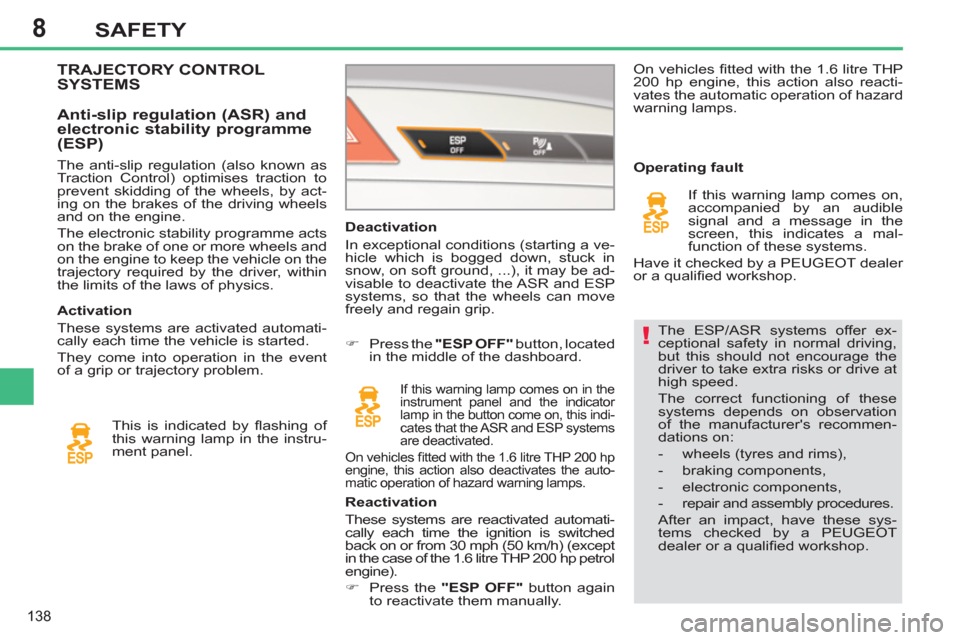
8
!
138
SAFETY
The ESP/ASR systems offer ex-
ceptional safety in normal driving,
but this should not encourage the
driver to take extra risks or drive at
high speed.
The correct functioning of these
systems depends on observation
of the manufacturer's recommen-
dations on:
- wheels (tyres and rims),
- braking components,
- electronic components,
- repair and assembly procedures.
After an impact, have these sys-
tems checked by a PEUGEOT
dealer or a qualifi ed workshop.
Deactivation
In exceptional conditions (starting a ve-
hicle which is bogged down, stuck in
snow, on soft ground, ...), it may be ad-
visable to deactivate the ASR and ESP
systems, so that the wheels can move
freely and regain grip.
�)
Press the "ESP OFF"
button, located
in the middle of the dashboard.
If this warning lamp comes on in the
instrument panel and the indicator
lamp in the button come on, this indi-
cates that the ASR and ESP systems
are deactivated.
On vehicles fi tted with the 1.6 litre THP 200 hp
engine, this action also deactivates the auto-
matic operation of hazard warning lamps.
Reactivation
These systems are reactivated automati-
cally each time the ignition is switched
back on or from 30 mph (50 km/h) (except
in the case of the 1.6 litre THP 200 hp petrol
engine).
�)
Press the "ESP OFF"
button again
to reactivate them manually.
Operating fault
If this warning lamp comes on,
accompanied by an audible
signal and a message in the
screen, this indicates a mal-
function of these systems.
Have it checked by a PEUGEOT dealer
or a qualifi ed workshop.
TRAJECTORY CONTROL
SYSTEMS
Activation
These systems are activated automati-
cally each time the vehicle is started.
They come into operation in the event
of a grip or trajectory problem.
Anti-slip regulation (ASR) and
electronic stability programme
(ESP)
This is indicated by fl ashing of
this warning lamp in the instru-
ment panel.
The anti-slip regulation (also known as
Traction Control) optimises traction to
prevent skidding of the wheels, by act-
ing on the brakes of the driving wheels
and on the engine.
The electronic stability programme acts
on the brake of one or more wheels and
on the engine to keep the vehicle on the
trajectory required by the driver, within
the limits of the laws of physics. On vehicles fi tted with the 1.6 litre THP
200 hp engine, this action also reacti-
vates the automatic operation of hazard
warning lamps.
Page 146 of 356
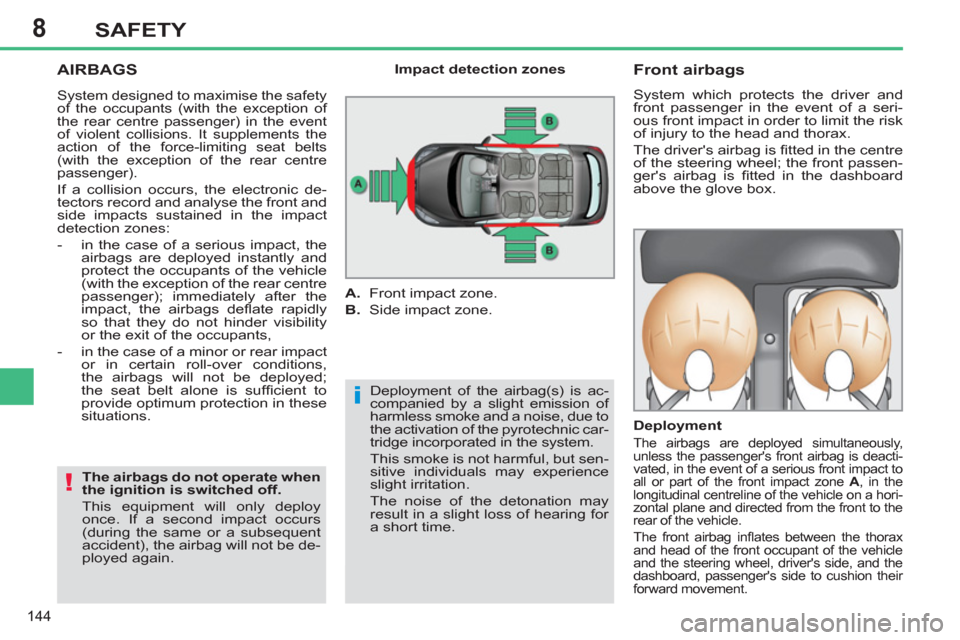
8
i
!
144
SAFETY
AIRBAGS
Deployment of the airbag(s) is ac-
companied by a slight emission of
harmless smoke and a noise, due to
the activation of the pyrotechnic car-
tridge incorporated in the system.
This smoke is not harmful, but sen-
sitive individuals may experience
slight irritation.
The noise of the detonation may
result in a slight loss of hearing for
a short time.
Front airbags
System which protects the driver and
front passenger in the event of a seri-
ous front impact in order to limit the risk
of injury to the head and thorax.
The driver's airbag is fi tted in the centre
of the steering wheel; the front passen-
ger's airbag is fi tted in the dashboard
above the glove box.
Deployment
The airbags are deployed simultaneously,
unless the passenger's front airbag is deacti-
vated, in the event of a serious front impact to
all or part of the front impact zone A
, in the
longitudinal centreline of the vehicle on a hori-
zontal plane and directed from the front to the
rear of the vehicle.
The front airbag infl ates between the thorax
and head of the front occupant of the vehicle
and the steering wheel, driver's side, and the
dashboard, passenger's side to cushion their
forward movement.
Impact detection zones
A.
Front impact zone.
B.
Side impact zone.
The airbags do not operate when
the ignition is switched off.
This equipment will only deploy
once. If a second impact occurs
(during the same or a subsequent
accident), the airbag will not be de-
ployed again.
System designed to maximise the safety
of the occupants (with the exception of
the rear centre passenger) in the event
of violent collisions. It supplements the
action of the force-limiting seat belts
(with the exception of the rear centre
passenger).
If a collision occurs, the electronic de-
tectors record and analyse the front and
side impacts sustained in the impact
detection zones:
- in the case of a serious impact, the
airbags are deployed instantly and
protect the occupants of the vehicle
(with the exception of the rear centre
passenger); immediately after the
impact, the airbags defl ate rapidly
so that they do not hinder visibility
or the exit of the occupants,
- in the case of a minor or rear impact
or in certain roll-over conditions,
the airbags will not be deployed;
the seat belt alone is suffi cient to
provide optimum protection in these
situations.